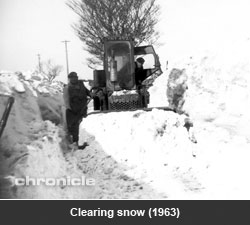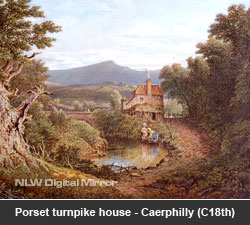
Roads
It is possible that many of the existing roads in the Caerphilly area are of great antiquity and once formed part of an ancient system of trade routes. Some of the old roads are used by today's traffic, whilst others are virtually forgotten and exist only as sunken tracks across the hillsides.
Old roads sometimes followed the high ground that was free of marsh and forestry. Today many of these old routes have been widened and altered; bypassing the places they once served.
There were roads or tracks in use in the Caerphilly area long before the coming of the Romans. It is possible that the Romans even made use of the existing roads as well as building their own. The Romans made their roads from beaten earth, on top of which they placed large stones bedded in mortar with layers of lime and gravel spread on top and finally finished with a paved surface. When the Romans left Britain, many of their roads were left to decay as they no longer went where people wanted to go and new roads were developed. But some of the most useful routes continued to be repaired, even as far as using the same techniques of the Romans, and were maintained beyond the medieval period.
A Roman Road through Caerphilly
The Roman road from Brecon ran south along the ridge of Gelligaer Common to the Roman camp at Gelligaer. Beyond Gelligaer the course of the road is less certain, but it seemed to have continued down the ridge to Pen-y-Bryn and turned southwest. A narrow lane crosses the valley and joins with the old road near Nelson, which is known as the Heol Fawr, or Great Road. The road continues over Mynydd Egwysilan and on to Energlyn, where it meets the road to Aber Valley. This road is marked as a Roman road on maps, and eventually forms a junction with four other roads at the Picadilly Square in Caerphilly.
Repairing the Highways
Before the onset of the industrial revolution, Britain's roads were in poor condition. Various laws were enacted to try to keep the King's Highways passable but often this legislation was difficult to implement. Whilst counties maintained main roads, parishes maintained local roads. Both were loath to spend their rents on repairs and those who did so employed local farmers rather than civil engineers. Some landowners realised that a good well-repaired highway was of assistance to their business but others neglected their duties, to the annoyance of their neighbours. During a discussion on the Monmouthshire roads, a spokesman giving evidence in favour of the Turnpike Act remarked, 'there are no roads, we travel in ditches'. Some of the descriptions of Welsh roads may have been exaggerated- one writer comments in 1777 that he is 'able to remove such discouraging apprehensions'.

Improving roads - The Turnpike Trusts
The first Turnpike Act was passed in 1756, although there was no serious thought given to establishing Turnpike Trusts in Glamorgan until 1760, when Turnpike trusts began to lease sections of the King's Highway. The trusts charged tolls which were based on the size or weight of a vehicle and paid for widening, straightening and improving the roads. The improved roads were ideal for the rapid movement of people, luggage, mail and small items of freight and worked in parallel with the slower canals, better suited for bulky goods.
The Turnpike roads were divided into sections, each being controlled by a gate or chain. To pass the gate, a toll had to be paid. Alongside each toll gate was a cottage that was occupied by the toll keeper and his wife. Sometimes the wife collected the tolls whilst the husband was out repairing the highway.
Caerphilly was surrounded by toll gates. There were toll gates at Porset Lane, at Pwllypant, alongside Van Road near Van Manor and at the foot of Nantgarw Hill. There was also a toll gate at Lower Machen, and across the river from Machen the other road to Caerphilly was barred by a gate at Draethen. There was also another at Werncaiach, Nelson.
By the 1820's, the network of roads had been completed (and may be seen on the 1844 Parliamentary report). They were traversed by pack horses or mules, carriages and stagecoaches and considered an effective method of transporting goods, despite the fact that the tolls were unpopular and the roads often patrolled by highwaymen.
After the Turnpikes
The profits to be gained by the Turnpike Trusts diminished with the coming of the railways in the late 1800's. When compared to railways, roads were an expensive and inefficient method of transporting the vast quantities of heavy goods required to supply the growing demands of the new factories. Many of the trusts had fallen into debt by the 1860's whilst others were abandoned to the local authorities when they were no longer profitable to run. However, the Caerphilly Trust published its last records in 1844, and appears to have been £130 in credit! The Turnpike Trust system wound up completely in 1892.
Highways today
The construction of motorways drew a lot of trade back from canals and railways and today road transport is seen as well suited to cope with short journeys.
Image date: unknown
Location: unknown
Submitted by: unknown
Do you have any stories, images and interesting facts relating to this picture. Help Chronicle build a website of your Caerphilly County Borough memories. Email the webmaster telling us as much as you can about your pictures. Thank you
Description: